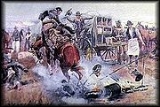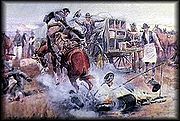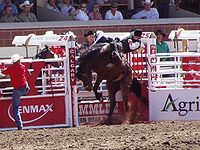
Bronco
Encyclopedia


United States
The United States of America is a federal constitutional republic comprising fifty states and a federal district...
, northern Mexico
Mexico
The United Mexican States , commonly known as Mexico , is a federal constitutional republic in North America. It is bordered on the north by the United States; on the south and west by the Pacific Ocean; on the southeast by Guatemala, Belize, and the Caribbean Sea; and on the east by the Gulf of...
and Canada
Canada
Canada is a North American country consisting of ten provinces and three territories. Located in the northern part of the continent, it extends from the Atlantic Ocean in the east to the Pacific Ocean in the west, and northward into the Arctic Ocean...
to refer to an untrained
Horse training
Horse training refers to a variety of practices that teach horses to perform certain behaviors when asked to do so by humans. Horses are trained to be manageable by humans for everyday care as well as for equestrian activities from horse racing to therapeutic horseback riding for people with...
horse
Horse
The horse is one of two extant subspecies of Equus ferus, or the wild horse. It is a single-hooved mammal belonging to the taxonomic family Equidae. The horse has evolved over the past 45 to 55 million years from a small multi-toed creature into the large, single-toed animal of today...
or one that habitually buck
Bucking
Bucking is a movement performed by a horse or bull in which the animal lowers his head and raises his hindquarters into the air, usually while kicking out with his hind legs. If powerful, it may unseat the rider enough so that he falls off....
s. It may refer to a feral horse
Feral horse
A feral horse is a free-roaming horse of domesticated ancestry. As such, a feral horse is not a wild animal in the sense of an animal without domesticated ancestors. However, some populations of feral horses are managed as wildlife, and these horses often are popularly called "wild" horses...
that has lived in the wild its entire life, but is also used to refer to domestic horses not yet fully trained to saddle
Saddle
A saddle is a supportive structure for a rider or other load, fastened to an animal's back by a girth. The most common type is the equestrian saddle designed for a horse, but specialized saddles have been created for camels and other creatures...
, and hence prone to unpredictable behavior, particularly bucking. The term also refers to bucking horses used in rodeo
Rodeo
Rodeo is a competitive sport which arose out of the working practices of cattle herding in Spain, Mexico, and later the United States, Canada, South America and Australia. It was based on the skills required of the working vaqueros and later, cowboys, in what today is the western United States,...
"rough stock" events, such as bareback bronc riding
Bronc riding
Bronc riding, either saddle bronc or bareback bronc competition, is a rodeo event that involves a rodeo participant riding on a horse , that attempts to throw or buck off the rider...
and saddle bronc
Rodeo
Rodeo is a competitive sport which arose out of the working practices of cattle herding in Spain, Mexico, and later the United States, Canada, South America and Australia. It was based on the skills required of the working vaqueros and later, cowboys, in what today is the western United States,...
riding. The silhouette of a cowboy on a bucking bronco is the official symbol for the State of Wyoming
Wyoming
Wyoming is a state in the mountain region of the Western United States. The western two thirds of the state is covered mostly with the mountain ranges and rangelands in the foothills of the Eastern Rocky Mountains, while the eastern third of the state is high elevation prairie known as the High...
.
In modern usage, the word is seldom used any longer to refer to a "wild," or more accurately, a feral horse
Feral horse
A feral horse is a free-roaming horse of domesticated ancestry. As such, a feral horse is not a wild animal in the sense of an animal without domesticated ancestors. However, some populations of feral horses are managed as wildlife, and these horses often are popularly called "wild" horses...
, because today, the modern rodeo bucking horse is a domestic animal. Some are specifically bred for bucking ability and raised for the rodeo, while others are spoiled riding horses who have learned to quickly and effectively throw off riders. Informally, the term is often applied in a joking manner to describe any horse that acts up and bucks with or without a rider. The Wild Horse Protection Act prevents the capture of mustangs
Mustang (horse)
A Mustang is a free-roaming horse of the North American west that first descended from horses brought to the Americas by the Spanish. Mustangs are often referred to as wild horses, but there is intense debate over terminology...
from the wild for commercial use, and though the law has been weakened in recent years, "wild" mustangs and other completely untamed horses are still no longer used on the rodeo circuit, as bigger, more powerful animals that are sufficiently domesticated
Domestication
Domestication or taming is the process whereby a population of animals or plants, through a process of selection, becomes accustomed to human provision and control. In the Convention on Biological Diversity a domesticated species is defined as a 'species in which the evolutionary process has been...
to be handled from the ground for veterinary care, travel, and stabling in small pens are more desirable as rodeo stock.
In the early American west, most cattle ranches simply allowed young horses to grow up in a feral
Feral
A feral organism is one that has changed from being domesticated to being wild or untamed. In the case of plants it is a movement from cultivated to uncultivated or controlled to volunteer. The introduction of feral animals or plants to their non-native regions, like any introduced species, may...
state on the open range, capturing them at maturity to be broken-in or "broke" to make them tame enough to ride. Sometimes Mustangs
Mustang (horse)
A Mustang is a free-roaming horse of the North American west that first descended from horses brought to the Americas by the Spanish. Mustangs are often referred to as wild horses, but there is intense debate over terminology...
were rounded up as well, as the two populations often mixed.
Etymology
The term comes from the Spanish languageSpanish language
Spanish , also known as Castilian , is a Romance language in the Ibero-Romance group that evolved from several languages and dialects in central-northern Iberia around the 9th century and gradually spread with the expansion of the Kingdom of Castile into central and southern Iberia during the...
word bronco, meaning "rough", which in Mexican
Mexican Spanish
Mexican Spanish is a version of the Spanish language, as spoken in Mexico and in various places of Canada and the United States of America, where there are communities of Mexican origin....
usage also describes a horse. It was then borrowed and adapted in US cowboy
Cowboy
A cowboy is an animal herder who tends cattle on ranches in North America, traditionally on horseback, and often performs a multitude of other ranch-related tasks. The historic American cowboy of the late 19th century arose from the vaquero traditions of northern Mexico and became a figure of...
lingo. It has also been spelled "broncho," though this form is virtually unknown in the western United States
Western United States
.The Western United States, commonly referred to as the American West or simply "the West," traditionally refers to the region comprising the westernmost states of the United States. Because the U.S. expanded westward after its founding, the meaning of the West has evolved over time...
, where the word is most common. Many other instances of cowboy jargon
Jargon
Jargon is terminology which is especially defined in relationship to a specific activity, profession, group, or event. The philosophe Condillac observed in 1782 that "Every science requires a special language because every science has its own ideas." As a rationalist member of the Enlightenment he...
were similarly borrowed from Mexican cowboys, including words such lariat
Lasso
A lasso , also referred to as a lariat, riata, or reata , is a loop of rope that is designed to be thrown around a target and tighten when pulled. It is a well-known tool of the American cowboy. The word is also a verb; to lasso is to successfully throw the loop of rope around something...
, chaps
Chaps
Chaps are sturdy coverings for the legs consisting of leggings and a belt. They are buckled on over trousers with the chaps' integrated belt, but unlike trousers they have no seat and are not joined at the crotch. They are designed to provide protection for the legs and are usually made of leather...
, and buckaroo
Buckaroo
A Buckaroo is a cowboy of the vaquero tradition of the Great Basin and California regions of the United States, particularly one skilled in the handling of horses...
, which are in turn corruptions of the Spanish la riata, chaparajos, and vaquero
Cowboy
A cowboy is an animal herder who tends cattle on ranches in North America, traditionally on horseback, and often performs a multitude of other ranch-related tasks. The historic American cowboy of the late 19th century arose from the vaquero traditions of northern Mexico and became a figure of...
. In modern English, the "o" is commonly dropped, particularly in the American west, and the animal simply called a "bronc."

